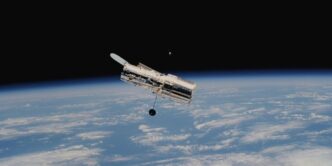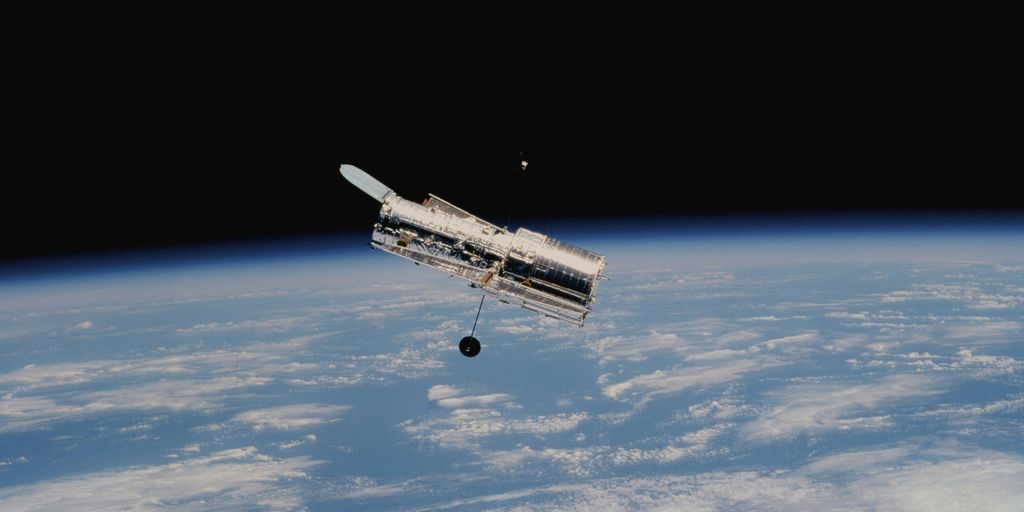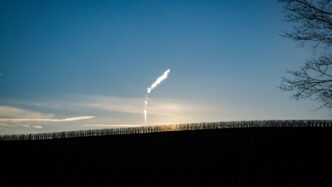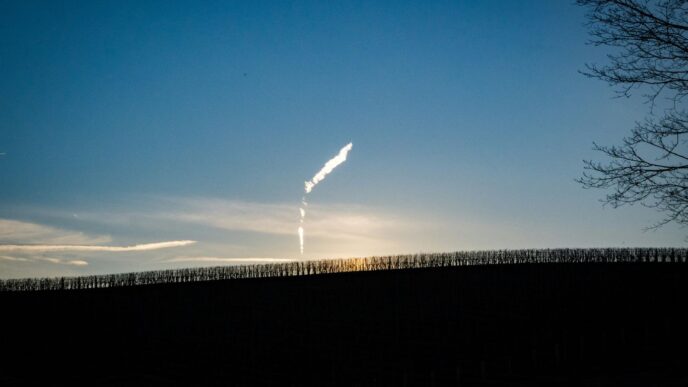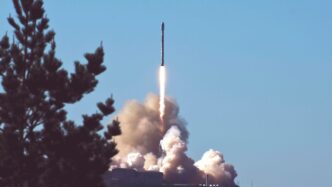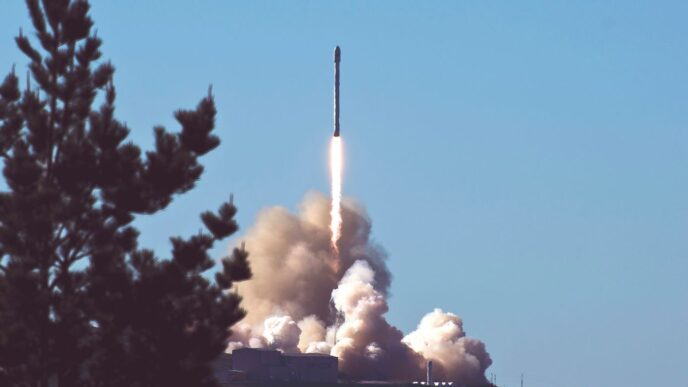You know, space is getting pretty crowded, and keeping all those satellites running is a big deal. That’s where companies like Katalyst Space Tech come in. They’re working on ways to fix, upgrade, and generally keep satellites in good shape while they’re up there. It’s not just about launching things anymore; it’s about maintaining them too. This whole idea of servicing satellites in orbit is pretty new, but it could change how we use space, especially for important military missions. Let’s look at what Katalyst Space Tech is doing and why it matters.
Key Takeaways
- Katalyst Space Tech is focused on improving satellites after they’ve been launched, adding new features or fixing them to extend their usefulness, particularly for those in high orbits.
- A major project involves using a robotic arm to attach a new imaging sensor, called SIGHT, made by Katalyst Space Tech, to a military satellite in space, a complex task planned for 2025.
- This mission is a team effort, with companies like Space Inventor building the satellite to carry the payload, and DARPA and the Naval Research Laboratory developing the robotic arm technology needed for the attachment.
- The Defense Innovation Unit (DIU) is coordinating these efforts, bringing together commercial tech like Katalyst’s sensors with military needs to boost readiness and training for the Space Force.
- Katalyst Space Tech’s work is also about making space more sustainable by developing technologies that could help track debris and potentially support a more circular economy in orbit.
Katalyst Space Tech’s Vision for Satellite Servicing
Katalyst Space Technologies is really changing how we think about satellites. Instead of just launching them and hoping for the best, they’re looking at ways to give them new life and add new features after they’re already up there. It’s like giving your old car a turbo boost and a new sound system, but in space.
Their main idea is to expand what satellites can do, going beyond what they were originally built for. This is especially important for satellites way out in geosynchronous orbit, about 22,000 miles up. It’s a tough spot to reach, so being able to fix or upgrade them there is a big deal.
Expanding Satellite Capabilities Beyond Original Design
Think about it: a satellite is launched with a specific job. But what if its sensors get old, or a new threat emerges that it needs to see? Katalyst’s approach means we don’t have to just launch a whole new, expensive satellite. They’re developing ways to add new capabilities, like better cameras or other sensors, to existing satellites. This makes the initial investment last much longer and keeps the satellite relevant.
Unlocking Features for Modular Space Platforms
This is also about making satellites more like building blocks. The idea is that future satellites could be designed with servicing in mind, allowing different modules or upgrades to be swapped in and out. Katalyst’s work is a step towards that future, showing that we can indeed add new parts to satellites already in orbit. It opens up a lot of possibilities for making space systems more flexible and adaptable.
Focus on Geosynchronous Orbit Enhancements
Geosynchronous orbit (GEO) is a prime spot for many important satellites, like communication and weather satellites. But it’s also a very crowded and distant place. Being able to service satellites in GEO means we can keep these vital assets working longer and better. Katalyst is focusing on making these upgrades happen in GEO, which is a technically demanding but very rewarding area to work in.
Pioneering In-Orbit Upgrades with SIGHT Payload
Katalyst Space Technologies is really pushing the envelope with their SIGHT payload, aiming to give satellites a serious upgrade while they’re already up there, orbiting Earth. Think of it like giving your car a new engine without ever having to bring it back to the garage. This isn’t just some theoretical idea; they’re working on a mission planned for 2025 that will see a robotic satellite in geostationary orbit, a whopping 22,000 miles up, attaching a new imaging sensor to a military satellite.
Attaching New Imaging Sensors in Geostationary Orbit
This is where the real magic happens. The SIGHT payload itself is an advanced electro-optical imaging sensor. Its job is to give satellites a better view of what’s going on around them, which is super important for keeping an eye on things in space. The plan is to attach this new sensor to a satellite that’s already in orbit, specifically to its launch adapter ring. This is a tricky job, requiring a specialized servicing vehicle equipped with a robotic arm. The arm technology comes from a collaboration between DARPA and the Naval Research Laboratory, and it’s designed for these kinds of delicate maneuvers.
Retrofit Attachment System for Satellite Integration
To make attaching the SIGHT sensor possible, Katalyst developed what they call a Retrofit Attachment System. This system is pretty clever; it’s designed to securely connect the new payload to the satellite’s existing structure. It’s not a one-size-fits-all deal, either. The system is engineered to work with the satellite’s launch adapter ring, which is a standard part of how satellites are initially put into space. This means they can potentially upgrade a variety of satellites without needing custom solutions for each one. It’s all about making the process as straightforward as possible, given the complexity of working in space.
Enhancing Space Domain Awareness with Advanced Sensors
So, why go through all this trouble? The main goal is to boost what’s known as Space Domain Awareness (SDA). Having better sensors means being able to track objects in orbit more effectively, whether that’s other satellites, space debris, or potential threats. For military operations, this is a big deal. It helps in understanding the space environment, planning missions, and maintaining readiness. The SIGHT payload, by providing enhanced imaging capabilities, directly contributes to this by giving operators a clearer, more detailed picture of the orbital landscape. This improved awareness is key for everything from collision avoidance to monitoring activities in critical orbital zones.
Key Partnerships Driving Mission Success
It takes a village, or in this case, a whole constellation of partners, to make big things happen in space. Katalyst Space Tech isn’t going it alone; they’ve teamed up with some seriously smart folks to get their satellite servicing ideas off the ground. Think of it like building a really complicated Lego set – you need all the right pieces and people who know how to put them together.
Collaboration with Space Inventor for Hosting Satellite
First up, we have Space Inventor. These guys are providing the actual satellite platform that will carry Katalyst’s new tech into orbit. It’s like Space Inventor is building the truck, and Katalyst is loading it up with the special cargo. This partnership is pretty straightforward: Space Inventor builds the ride, and Katalyst puts its gear on it.
DARPA and NRL’s Robotic Arm Technology
Then there’s the really cool robotic stuff. DARPA and the Naval Research Laboratory (NRL) have been working on some advanced robotic arm technology. This isn’t just any arm; it’s designed for the delicate work needed in space. The plan is to put these arms on a vehicle built by SpaceLogistics (a Northrop Grumman company) to actually do the attaching of new equipment to satellites already in orbit. So, DARPA and NRL are providing the super-dexterous hands for the job.
Defense Innovation Unit’s Role in Project Coordination
And who’s keeping all these different players on the same page? That would be the Defense Innovation Unit (DIU). DIU is like the project manager for the whole operation. They’re focused on bringing new commercial technologies into military space operations. DIU helped pick the companies involved and made sure everyone was working together. They’re also involved with the Pentagon’s Test Resource Management Center, which is chipping in some cash to help make this whole thing happen. It’s all about getting new ideas into the military’s hands faster.
Basically, Katalyst has brought together a team with expertise in building satellites, creating advanced robotic tools, and managing complex projects. It’s a solid lineup, and it shows how important teamwork is when you’re trying to do something as ambitious as upgrading satellites while they’re floating way up there in space.
The Role of Katalyst Space Technologies in Military Space Operations

Katalyst Space Technologies is really changing the game for how the military uses satellites. Think about it, most satellites are built for a specific job and then they’re done. But what if you could just add new parts, like upgrading your phone? That’s what Katalyst is working on.
Extending Satellite Lifespan for Operational Readiness
One of the biggest things Katalyst is doing is making satellites last longer. Satellites are expensive, and losing one means losing a capability. By being able to add new sensors or fix things while they’re already in space, they can keep satellites working for much longer. This means the Space Force doesn’t have to launch as many new ones, saving money and keeping important missions running. It’s like giving a satellite a tune-up instead of buying a whole new car. This approach is key for maintaining what they call "operational readiness," making sure the military always has the tools it needs in space. They’re working with groups like the Defense Innovation Unit to make this happen.
Supporting Space Force Training and Wargames
Katalyst’s technology also helps with training. The Space Force’s Delta 11 unit, for example, uses satellites for training exercises and wargames. Imagine trying to practice space combat with outdated equipment – it’s not very realistic. By upgrading satellites with better sensors, Katalyst helps create more accurate training environments. This means Space Force personnel can practice maneuvers and strategies in conditions that are much closer to what they’d face in a real situation. It’s a big step up from just using simulations.
Fusion of Commercial Innovation and Military Needs
What’s really neat is how Katalyst is bringing together commercial tech with military requirements. They’re not just building something for the military in a vacuum. They’re taking ideas that work in the commercial space world and adapting them for defense. This partnership approach means they can move faster and use the latest technology. It’s a smart way to get advanced capabilities into the hands of the military without reinventing the wheel. This collaboration is vital for staying ahead in space operations. Here’s a look at some of the key players:
- Katalyst Space Technologies: Developed the SIGHT payload and the attachment system.
- Space Inventor: Providing the satellite platform to host the payload.
- DARPA and NRL: Created the robotic arm for the servicing vehicle.
- Northrop Grumman’s SpaceLogistics: Building the vehicle that will carry out the servicing mission.
- Space Force Delta 11: The end-user benefiting from the upgraded satellite.
Addressing Challenges in On-Orbit Servicing
Getting satellites fixed or upgraded while they’re floating way up there isn’t exactly a walk in the park. It’s a complex business, and there are definitely some hurdles Katalyst Space Tech, like everyone else in this field, has to jump over. One big one is just getting the money to build the actual flight hardware. You know, the stuff that actually goes into space. It’s not cheap, and you need a lot of it to prove your concept works.
Then there’s the whole issue of making sure these programs don’t just stop after the first test flight. You want them to keep going, to get bigger and better, but that means you need a steady stream of funding. It’s like trying to keep a campfire going – you need to add wood regularly, or it just dies out. Securing long-term financial backing is key to making on-orbit servicing a regular thing, not just a one-off experiment.
Finally, there’s the pressure of time. Space missions have tight schedules, and when you’re developing new technology, things can take longer than you expect. You have to balance the need to get things done quickly with the reality of how long it actually takes to design, build, and test new space gear. It’s a constant juggling act.
Here are some of the main challenges:
- Funding Flight Units: Getting enough money to build the actual hardware that will fly in space.
- Program Longevity: Making sure projects continue beyond initial demonstrations and don’t just fizzle out.
- Schedule Management: Keeping projects on track despite the inherent complexities and potential delays in space technology development.
- Dependency Management: Relying on other companies or technologies that also have their own timelines and funding issues.
Katalyst Space Tech’s Contribution to Space Sustainability
It’s easy to think about space as this vast, empty place, but it’s actually getting pretty crowded. We’ve got a lot of stuff up there, and not all of it is still working. That’s where companies like Katalyst Space Tech come in, thinking about how to make space cleaner and more useful for longer. They’re not just about putting new things into orbit; they’re also looking at how to keep existing things running better.
One of the big ideas is making space more like a workshop. Instead of just launching a satellite and hoping for the best for its whole life, imagine being able to swap out parts or add new tools. Katalyst is working on technologies that could let them attach new sensors or other equipment to satellites already in orbit. This means a satellite that was designed for one job could potentially do more, or its useful life could be extended significantly.
Think about it like this:
- Extending Satellite Lifespan: Instead of a satellite becoming obsolete or failing after its planned mission, it could be serviced. This means less need to launch entirely new satellites, which saves resources and reduces the amount of old hardware left floating around.
- Adding New Capabilities: A satellite might have a perfectly good body and power system, but its camera technology is outdated. With servicing, a newer, better camera could be attached, giving the satellite a new lease on life and new abilities.
- Reducing Space Junk: By servicing and extending the life of satellites, or by eventually bringing them down safely, the amount of debris in orbit can be reduced. This is a huge deal for keeping space safe and accessible for future missions.
Katalyst’s work on things like their SIGHT payload and retrofit attachment systems are steps towards this future. They’re developing the tools and methods that could make on-orbit servicing a common practice. This approach helps create a more sustainable space environment by maximizing the use of assets already in orbit and minimizing the creation of new space debris. It’s about being smarter with what we have up there, making space operations more efficient, and building a future where space activities don’t create more problems than they solve.
Looking Ahead
So, what does all this mean for the future? Well, it looks like satellites won’t just be stuck doing one job forever. Companies like Katalyst Space Tech are making it possible to actually upgrade them while they’re up there, way above our heads. Think about it – instead of launching a whole new satellite, we can just send up a robot to swap out a part or add a new sensor. This mission in 2025, upgrading a military satellite with a new camera, is a big step. It shows we can actually do this kind of work in space. It’s not just about keeping old satellites running longer; it’s about making them smarter and more useful. This kind of in-orbit servicing is changing how we think about space, making it more like a place where we can build, fix, and improve things, not just launch and forget.
Frequently Asked Questions
What is Katalyst Space Tech’s main goal?
Katalyst Space Tech wants to make satellites better and last longer. They are working on ways to add new tools, like cameras, to satellites already in space. This helps them do more than they were originally designed for, especially for satellites far away from Earth.
What is the SIGHT payload?
They are developing a special camera, called SIGHT, that can be attached to satellites in space. This upgrade can help keep an eye on things in space, like tracking other satellites or space junk.
Who are Katalyst Space Tech’s partners?
Katalyst is working with other companies and government groups. For example, Space Inventor is building the satellite that will carry their payload, and DARPA and the NRL helped create the robot arm that will do the attaching. The Defense Innovation Unit helps put it all together.
How does Katalyst Space Tech help the military?
These upgrades can help the military by making their satellites last longer and work better. This is useful for training and practicing missions in space, making sure they are ready for anything.
What are some challenges Katalyst Space Tech faces?
One big challenge is getting enough money to build and test the equipment. They also need to make sure that these upgrade programs continue after the first test, not just be a one-time thing. Making sure everything is done on time is also important.
How does Katalyst Space Tech help make space more sustainable?
By upgrading satellites and helping to track space junk, Katalyst is helping to keep space cleaner and safer. They are working on ways to reuse and fix things in space, which is good for everyone who uses space.

